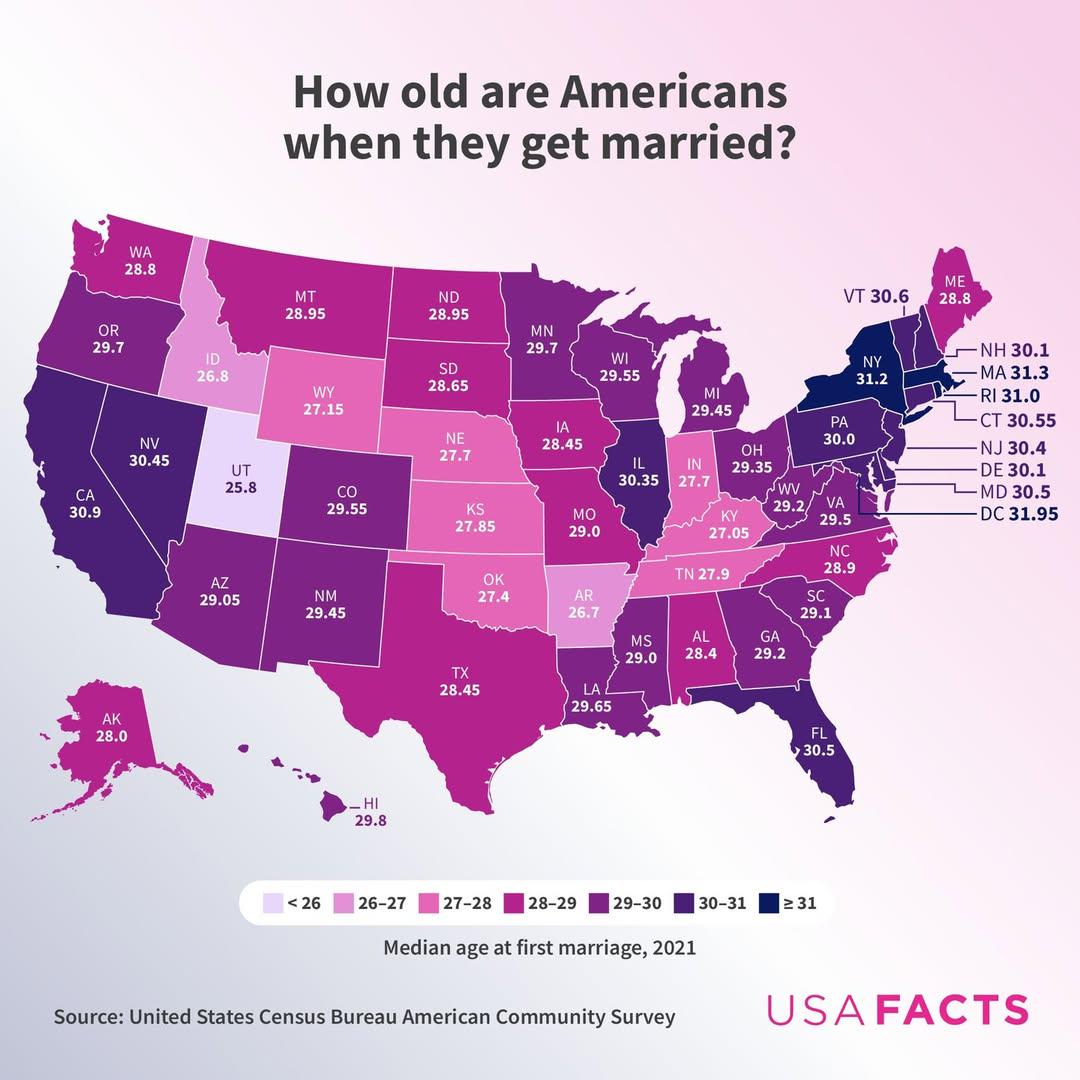Marriage Age in the U.S. Map


David Chen
Data Visualization Specialist
David Chen is an expert in transforming complex geographic datasets into compelling visual narratives. He combines his background in computer science ...
Geographic Analysis
What This Map Shows
This visualization provides a clear representation of the average age at which Americans first marry across various states. By using color coding, it highlights regional differences and trends that can give us insights into societal norms, economic factors, and cultural influences affecting marriage.
Deep Dive into Marriage Age in the U.S.
Marriage has long been a significant milestone in American society. Over the years, the age at which individuals first marry has seen considerable shifts, influenced by factors such as education, economic stability, and changing cultural values. Historically, people married in their early twenties, but recent trends indicate that Americans are choosing to tie the knot later in life.
Interestingly, the average age of first marriage for men is now around 30 years, while for women, it hovers around 28 years, according to the U.S. Census Bureau. This shift is attributed to several societal changes. For instance, an increasing number of individuals are pursuing higher education, which often delays marriage as they focus on establishing their careers. Additionally, economic considerations play a crucial role; many young adults prefer to achieve financial stability before committing to marriage.
Demographically, this trend varies widely across different regions of the United States. In states like Utah and Wyoming, the average marriage age tends to be younger, with many individuals marrying in their early twenties. This can be attributed to cultural factors and a strong emphasis on family values within these communities. Conversely, states like Massachusetts and New York show higher average marriage ages, reflecting urban lifestyles where individuals may prioritize career advancement and personal development over marriage.
The rise of cohabitation before marriage is another factor worth noting. Many couples today choose to live together before getting married, which can extend the timeline of marriage as they navigate their relationships and living situations. This trend is especially prominent in metropolitan areas where young adults are more likely to embrace non-traditional relationships.
In terms of racial and ethnic diversity, marriage age also exhibits variation. For instance, Hispanic and African American communities often have different patterns compared to their white counterparts, influenced by cultural traditions and socioeconomic factors. Research indicates that marriage rates and ages can also be affected by access to education and socioeconomic status, underscoring the complex interplay between personal choices and broader societal structures.
Regional Analysis
When we break down the map by region, distinct patterns emerge. In the South, states like Alabama and Mississippi report lower average marriage ages, often below the national average. This aligns with a more traditional view of marriage, where familial and community expectations may encourage earlier unions.
On the other hand, states in the Northeast, such as New York and New Jersey, showcase a trend of later marriages. Here, the average ages often exceed 30 for men and women alike. This can be attributed to the fast-paced lifestyle, high cost of living, and a greater focus on career establishment in urban areas.
The West also presents intriguing data. In states like California, the average marriage age is on the rise, reflecting the diverse population and varying values around relationships. Meanwhile, in the Midwest, states like Ohio and Indiana show an average age that falls somewhere between the Southern and Northeastern trends, indicating a mix of traditional and modern views on marriage.
Significance and Impact
Understanding the age at which Americans first marry is more than just a matter of statistics; it reflects evolving cultural norms and economic realities. As society continues to change, these marriage age trends can have far-reaching implications on family structure, economic growth, and social policies.
For example, delayed marriage often correlates with lower birth rates, which can impact everything from education funding to housing markets. Additionally, the shift in marriage patterns may influence discussions around health care, social security, and retirement planning, as individuals marry later and often choose to have children later in life.
Looking forward, it's fascinating to consider how these trends will continue to evolve. Will the average marriage age keep increasing as more people prioritize career and education? Or will we see a resurgence in early marriages as cultural values shift once again? Only time will tell, but the data captured in this map provides a valuable snapshot of where we are today, and where we might be headed in the future.
Visualization Details
- Published
- October 3, 2025
- Views
- 38
Comments
Loading comments...